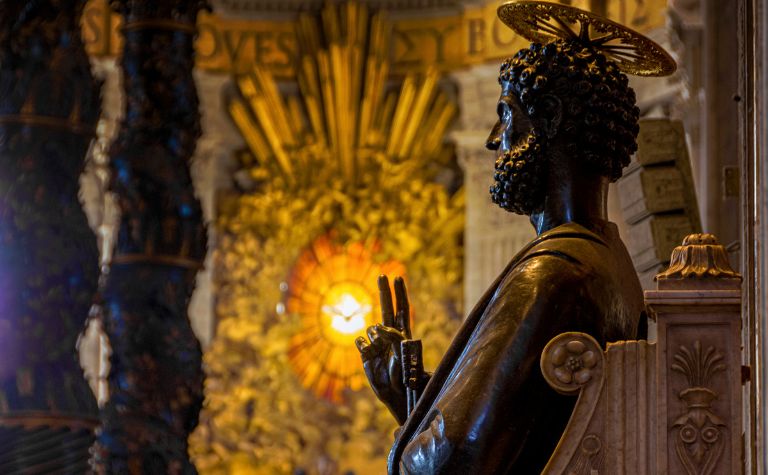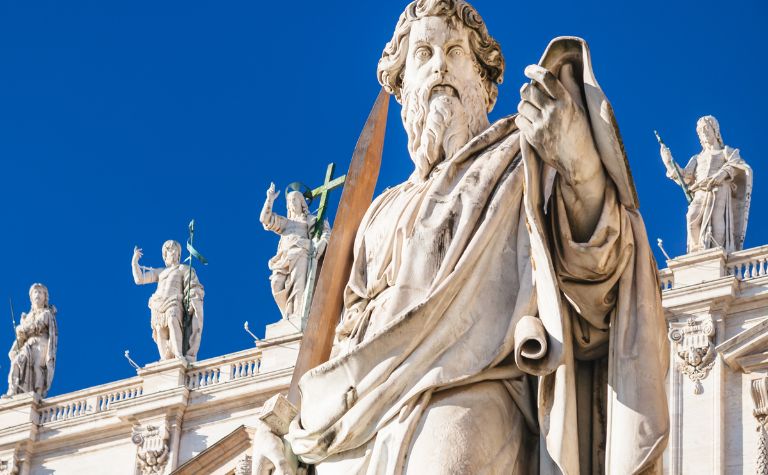Peter is one of the most influential figures in the Gospels, the New Testament, and the history of Christianity. He is known for laying down his fishing nets and following Jesus, confessing that Jesus is the Messiah, denying him three times, and then being forgiven by him. All that Peter said and did lead many people to wonder how he died.
The Bible doesn’t mention Peter’s death, although Jesus foretells it. Christian tradition says that during the reign of Nero, the Roman authorities crucified the Apostle upside down. Scholars and historians debate the strengths and weaknesses of the sources that record Peter’s death.
What did Jesus say about Peter’s death? What did Peter say about it in his own writing? What early church fathers mention Peter’s death? What do they say? What did Clement of Rome, who may have known Peter, write about his death? Keep reading to learn the answers to these questions and others.
Also, see How Did the Apostle Paul Die? to learn more.

Jesus Predicts Peter’s Death
The book of Acts preserves the historical record of the early church, but the narrative ends around 64 A.D. According to tradition, Peter died between 64-68 A.D., which was the most intense era of Nero’s persecution of Christians.
While Peter is still alive when Acts ends, Bible readers get some insight about his death from Jesus at the end of the Gospel of John.
After Jesus died and rose from the dead, he appeared to people for 40 days. However, people didn’t just see visions of him, but walked with him, touched him, and ate with him.
Peter will stretch out his hands in death
One morning, Jesus ate a fish breakfast with Peter. When they finished eating, Peter expressed his love for Jesus (John 21:15-17). Then Jesus forecasted the Apostle’s fate and spoke about how Peter would die.
“Truly, truly, I say to you, when you were young, you used to dress yourself and walk wherever you wanted, but when you are old, you will stretch out your hands, and another will dress you and carry you where you do not want to go” (John 21:18, ESV).
John adds, “This he said to show by what kind of death [Peter] was to glorify God. And after saying this he said to him, ‘Follow me’ (John 21:19, ESV).
Martyrdom and crucifixion
Most scholars believe that Jesus’ words indicated that Peter would be crucified, which is what tradition says occurred (more below). In addition, the imagery of arms stretched out reflects how Roman authorities nailed a person to a cross.
John scholar D.A. Carson explains, “In this context, the younger Peter carries the positive connotations of freedom, while the old here signals not serenity but restriction and martyrdom. More important is the way stretch out your hands was understood in the ancient world: it widely referred to crucifixion.” (emphasis Carson’s) [1]
New Testament historian Craig Keener agrees: “Jesus is explaining that when Peter is old and dependent, he will suffer execution… Early Christian tradition reports that Peter died by crucifixion, probably upside down, finally, ‘following’ Jesus fully; early Christian texts applied ‘stretching out one’s hands’ to crucifixion.” [2]
Peter’s words in 2 Peter 1:13-14 reveal that he understood Jesus’ prophetic words about his death. “I think it right, as long as I am in this body,h to stir you up by way of reminder, since I know that the putting off of my body will be soon, as our Lord Jesus Christ made clear to me” (ESV).
Also, see Why Did Peter Deny Jesus? to learn more.

Early Christian Writing About Peter’s Death
A letter from the late first century and a history book from the early fourth century mention Peter’s death. Historians debate their reliability. Nevertheless, they represent the earliest non-biblical record of how the Apostle died.
Clement of Rome mentions Peter’s death
Clement of Rome (35-99 A.D.) was a contemporary of the apostles. Some traditions say he knew Peter personally, but scholars and historians debate the validity of those sources. The only writing of Clement’s that has survived is a letter he wrote to the Christians at Corinth. In the letter, he mentions Peter’s death.
In chapter five of his letter, he writes, “Let us take the noble examples of our own generation. Through jealousy and envy the greatest and most just pillars of the Church were persecuted, and came even unto death… Peter, through unjust envy, endured not one or two but many labours, and at last, having delivered his testimony, departed unto the place of glory due to him.” [3]
Eusebius mentions Peter’s death
Eusebius of Caesarea (260-339 A.D.) is known as a historian in the early church. He was a scholar, writer, and bishop of Caesarea Maritima.
His book Ecclesiastical History represents the first time someone wrote a chronological narrative of Christianity. In the book, he mentions Peter’s death.
“Thus Nero publicly announcing himself as the chief enemy of God was led on his fury to slaughter the Apostles. Paul is therefore said to have been beheaded at Rome, and Peter to have been crucified under him. And this account is confirmed by the fact that the names of Peter and Paul still remain in the cemeteries of that city even to this day.” [4]
Also, see How Old Was Adam When He Died? to learn more.

Peter’s Death In Christian History
In the seventeenth century, Englishman Dorman Newman wrote The Lives and Deaths of the Early Apostles. Some church historians believe Newman may have had access to sources that don’t exist today.
About Peter’s death, Newman writes: “Peter was led to the top of the Vatican Mount near Tybur and crucified with his head downwards. His body was embalmed by Marcellinus the Presbyter after the Jewish manner, then buried in the Vatican near the Triumphal Way. Over his body a small church was erected. It was destroyed by Heliogalachis.” [5]
An example of a modern historian’s description of Peter’s death comes from George F. Jowett’s, The Drama of the Lost Disciples.
Jowett writes, “Peter, the Rock, as he predicted, met his death at Rome by the hands of the murderous Romans, who crucified him, according to their fiendish manner. He refused to die in the same position as our Lord, declaring he was unworthy.”
He continues: “Peter demanded to be crucified in the reverse position, with his head hanging downward. Ironically enough, this wish was gratified by the taunting Romans in Nero’s circus AD 67.” [6]
Most modern historians aren’t as confident as Jowett in explaining how Peter died. Many summarize the evidence from the early church and cite the details where there is general agreement but hesitate to accept other claims, especially from sources that clearly include myths and legends about Peter.
Also, see How Did Moses Die? to learn more.
References:
[1] The Gospel According to Matthew by D.A. Carson. p. 679.
[2] The Gospel of John: A Commentary by Craig S. Keener. Volume 2. p. 1238.
[3] 1 Corinthians by Clement of Rome. Chapter 5.
[4] Ecclesiastical History by Eusebius. p. 80.
[5] The Lives and Deaths of the Holy Apostles by Dorman Newman. p. 20.
[6] The Drama of the Lost Disciples by George F. Jowett. p. 176.
Related Questions
Regular Bible reading is a valuable habit, as Scripture is God's message to people. However, the Bible's 66 distinct books, featuring various authors, settings, and themes, can make it challenging...
There are 66 individual books in the Bible. There are 39 in the Old Testament and 27 in the New Testament. Many readers can read the shortest books in the Bible in 5 to 10 minutes. The longest book...
